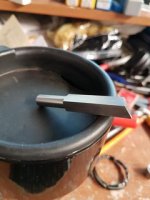I am a local blacksmith in Arizona. Currently making a few swage blocks and considering broaching square holes or milling, which ever might be cost effective and less time consuming. I was hoping to get ideas on tooling and or methods of broaching these holes from you folks. Here is a list of holes I need to broach.
2.000"
1.500"
1.125"
1.000"
0.875"
0.750"
0.625"
These holes will be through a 2 inch thick plate I believe to be A350 steel.
Any help is greatly appreciated.
Robert Ratliff
Blacksmith
2.000"
1.500"
1.125"
1.000"
0.875"
0.750"
0.625"
These holes will be through a 2 inch thick plate I believe to be A350 steel.
Any help is greatly appreciated.
Robert Ratliff
Blacksmith




